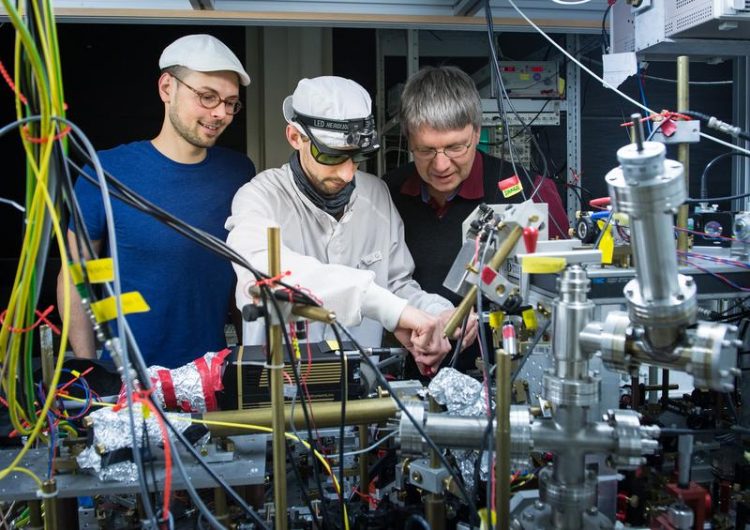Two or one splashing? It’s different!

In the lab: Dr. René Reimann, Tobias Macha and Prof. Dr. Dieter Meschede from the Institute of Applied Physics of the University Bonn. (c) Photo: Volker Lannert/Uni Bonn
The physicists at the University of Bonn confined two levitating cesium atoms in a light cage for photons. A laser beam continuously irradiated the two atoms, which scattered the laser light similar to levitating dust in a sunbeam. The scattered light waves superimpose and were reflected back onto the atoms by two parallel mirrors.
“We expected that two atoms in such a cage would behave differently from a single atom” says first author Dr. René Reimann, colleague of Prof. Dr. Dieter Meschede at the “Institut für Angewandte Physik”, University of Bonn. This matches with our everyday experience: Two splashing children in the sea produce different water waves than a single child. However, for the light cage with the light waves emitted from the two atoms the analogy to the splashing children in the sea does not fully hold. Here no high light waves are observed.
Backaction suppresses high light waves
The surprising situation of the two atoms inside the light cage can be illustrated with two children in a swimming pool instead of the sea. Here the children create water waves that are partially reflected from the pool edge. Now the reflected waves and the forward running waves cancel each other. “Due to this feedback two children can in the best case generate barely higher waves than a single child”. Albeit by changing the distance between them, the kids in the pool can change the height of the water waves.
Keeping this in mind one can understand the situation of the two cesium atoms in the experiment: Even in the best case when the light waves of the two atoms constructively interfere barely more photons could be counted compared to the one atom case. “It became clear that the mirrors introduce a strong backaction that hinders the emergence of high light waves”, describes Dieter Meschede.
New insights in light-matter interaction
Nevertheless minimal position changes of the levitating cesium atoms in the light cage can be detected through distinct changes in the height of the superimposed light waves. “Up to now this was not possible. Now, this opens up new insights and experimental possibilities for the light-atom interaction of two-atom systems”, says René Reimann. These new possibilities could support forward-looking technologies like quantum memories and quantum networks for telecommunication and computation.
So far, international teams of scientists observed the interaction of a single or many atoms with photons in a light cage. For his fundamental contributions to this research, Serge Haroche was awarded the Nobel Prize in physics in 2012. Now, the physicists from Bonn achieved to observe the interaction of exactly two atoms in a light cage. “With this experiment the most fundamental case of collective light-matter interaction has been realized”, says Dieter Meschede.
The research group “Quantum Technologies” at the University of Bonn experimentally investigates the controlled interaction between atoms and light. The group is focusing on the generation of particular quantum mechanical states.
Publication: R. Reimann, W. Alt, T. Kampschulte, T. Macha, L. Ratschbacher, N. Thau, S. Yoon, D. Meschede, Cavity-Modified Collective Rayleigh Scattering of Two Atoms, Physical Review Letters, DOI: 10.1103/PhysRevLett.114.023601
Contact information for media:
Dr. René Reimann
Institut für Angewandte Physik
Forschungsgruppe Quantentechnologie
Tel. 0228/733489
E-Mail: reimann@iap.uni-bonn.de
Prof. Dr. Dieter Meschede
Institut für Angewandte Physik
Forschungsgruppe Quantentechnologie
Tel. 0228/733477
E-Mail: meschede@uni-bonn.de
Media Contact
More Information:
http://www.uni-bonn.de/All latest news from the category: Physics and Astronomy
This area deals with the fundamental laws and building blocks of nature and how they interact, the properties and the behavior of matter, and research into space and time and their structures.
innovations-report provides in-depth reports and articles on subjects such as astrophysics, laser technologies, nuclear, quantum, particle and solid-state physics, nanotechnologies, planetary research and findings (Mars, Venus) and developments related to the Hubble Telescope.
Newest articles

NASA: Mystery of life’s handedness deepens
The mystery of why life uses molecules with specific orientations has deepened with a NASA-funded discovery that RNA — a key molecule thought to have potentially held the instructions for…

What are the effects of historic lithium mining on water quality?
Study reveals low levels of common contaminants but high levels of other elements in waters associated with an abandoned lithium mine. Lithium ore and mining waste from a historic lithium…

Quantum-inspired design boosts efficiency of heat-to-electricity conversion
Rice engineers take unconventional route to improving thermophotovoltaic systems. Researchers at Rice University have found a new way to improve a key element of thermophotovoltaic (TPV) systems, which convert heat…



